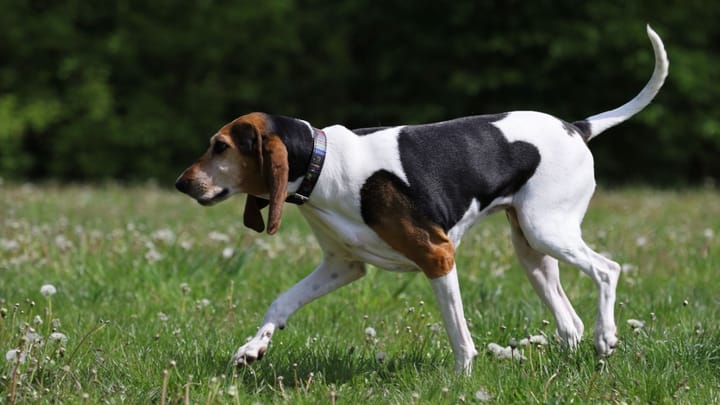English Foxhound
Other name: Foxhound


The English Foxhound is a proud and very active dog, a family man who loves to work outdoors and may feel restrained by city life. While the Foxhound can make a great addition to the right home, it is worth noting that – sadly – his bounteous skills and energies are mostly exploited for foxhunting, rather than as a pet. Pet owners can satisfy his urges with long walks and runs, and games of fetch. If you can make this fast chasing-dog out from the blur he leaves when running, you’ll find him a handsome and noble creature.
|
Life expectancy |
The English Foxhound has a life expectancy of between 10 and 12 years |
|
Temperament |
|
|
Size |
Large
|
|
Adult size |
Female
Between 23 and 25 in
Male
Between 23 and 25 in
|
|
Adult weight |
Female
Between 55 and 77 lb
Male
Between 55 and 77 lb
|
|
Coat colour
Usually white with any combination of tan, red, or black markings. |
Black White Brown Blue Red Sand |
|
Type of coat
Short, dense, and waterproof. |
Short |
|
Eye colour
Hazel or brown. |
Brown
|
|
Purchase price |
The English Foxhound costs between £350 and £1050 |
This dog is not commonly kept as a pet and it can take some time to find an available puppy. The English Foxhound is one of the ancestors of the very popular breed: the English Pointer.
More details about the English Foxhound
English Foxhound: Origins and history
Up until the middle-ages, the fox was generally hunted by farmers and working people to protect livestock. But with the dwindling of the British stag population, the aristocracy – who had, until now, sated their bloodlust with the hunting of deer – elected to hunt foxes for sport instead. Around the 16-17th century, efforts were made to develop a dog breed that took the tracking skills of traditional stag hounds and the pace and agility of nippier dogs, and the English Foxhound was born. He has remained in work ever since, only rarely becoming a house dog, and even then not until his retirement years. Since the 18th century, the British Foxhound Association has been managing the Masters’ book of origins, which lists the genealogies of all Foxhounds.
Physical characteristics of the English Foxhound
The Foxhound may be kind of pretty, but he’s also tall and strong. This barrel-chested sportsman has a large skull and a medium-long beak which nestles beneath two dreamy and somewhat melancholic eyes. His ears are seductively flappy, his coat beautifully patterned, and his tail firm and erect. But like so many sportsmen, he is susceptible to piling on the pounds when out of training – so if you spot a dog that matches this description, perhaps on the portly side, you may have found yourself an English Foxhound. N.B. This creature is slightly stouter and shorter in the leg than his near-identical cousin the American Foxhound.
FCI classification of the English Foxhound
-
Group 6 - Scent hounds and related breeds
-
Section 1 : Scent hounds
English Foxhound: Characteristics
English Foxhound: Behaviour
Training a English Foxhound
The Foxhound can be stubborn, and a good understanding of foxhound mentality is recommended.
English Foxhound: Lifestyle
Breed compatibility English Foxhound
English Foxhound: Purchase price
Between £350 for Non KC Registered Dogs, and £1,050 for KC Registered Dogs. Looking after a dog such as the Foxhound typically costs between £60 to £100 a month, including food, medical/insurance, and incidental expenses.
English Foxhound: Shedding
Average
Moderate shedder.
English Foxhound: Grooming
This dog’s coat is durable and requires little grooming. Weekly brushing, with special attention paid to the ear flaps, is recommended.
English Foxhound: Health
The Foxhound is generally a healthy dog with an average life expectancy of 10 to 12 years.
This is a tough and durable dog.
Fairly well, but it’s not recommended to work this dog too intensively during a heat wave.
His fur gives him fairly good protection from the cold.
His high energy helps him to maintain his trim form.
- Bloating (gastric dilatation-volvulus)
- Ear infections
- Obesity








